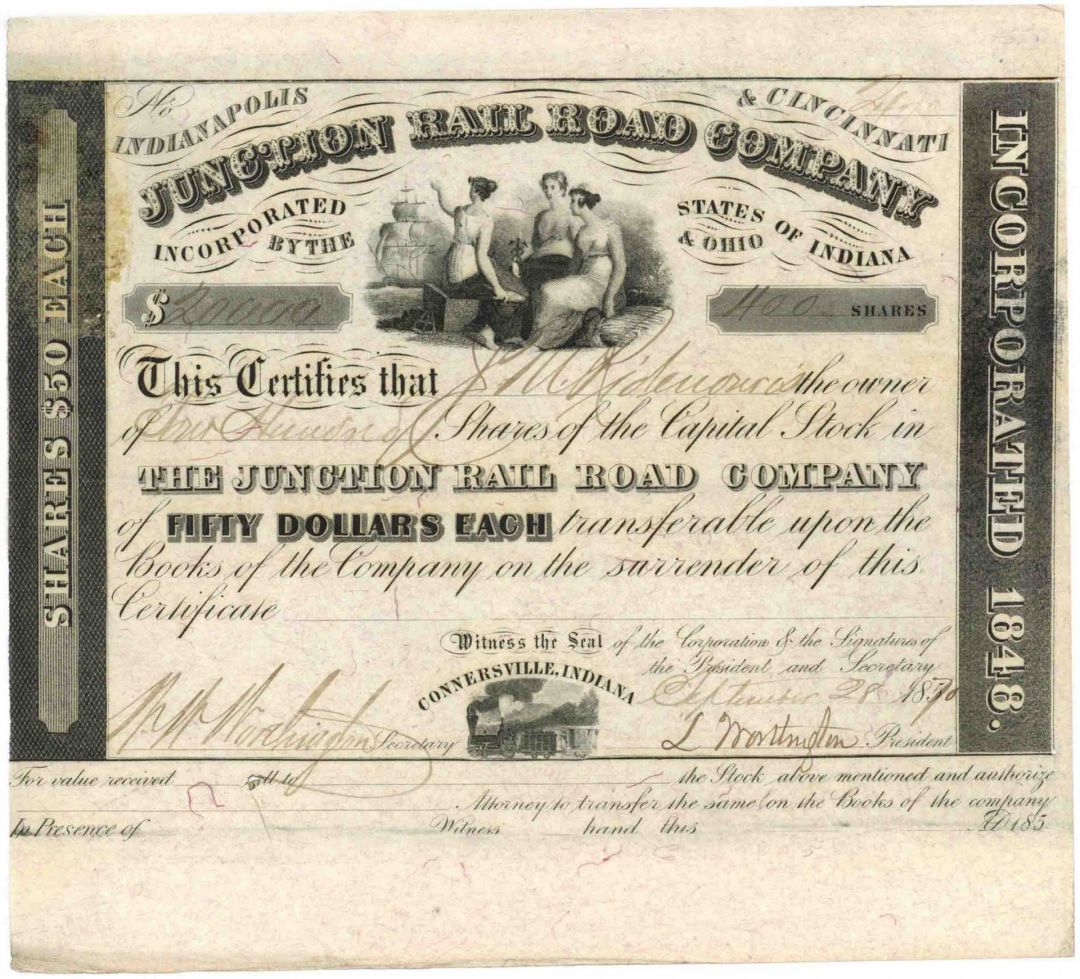Indianapolis and Cincinnati Junction Railroad - Indiana & Ohio Railway Stock Certificate
Inv# RS2735 StockOhio
Unissued Stock. National Bank Note Co., NY. Superb Vignette!
The main force behind the Cincinnati, Hamilton & Dayton Railroad was John Alexander Collins (1815-1878) who had come from Stafford, England in 1825 and worked as a locomotive engineer before coming to Ohio in 1851. Organized as Cincinnati and Hamilton Railroad Company, under special act, March 2, 1846 , to construct a railroad from Cincinnati to Hamilton, Ohio; corporate title changed by act dated February 8, 1847, to Cincinnati, Hamilton and Dayton Railroad Company; additional powers conferred by act of March 15, 1849, to extend line of road from Hamilton to Dayton.
This company leased in perpetuity, on May I, 1863, the Dayton and Michigan Railroad, and on February 18, 1869, the Cincinnati, Richmond and Chicago Railroad. During the winter of 1872-73 it also obtained possession of the Cincinnati and Indianapolis Junction Railroad, extending from Hamilton via Connersville to Indianapolis. In 1865, the CH&D allied with the Atlantic & Great Western (later the Erie Railroad), providing access to New York and other eastern points, and the Ohio & Mississippi Railroad, linking Cincinnati and St. Louis through Indiana and Illinois.
From Dayton to Cincinnati the road was used for the trains of the Atlantic and Great Western, so the track was constructed with four rails, to accommodate the 4 feet 10 inches and the 6 feet gauges, and with an ample mileage of side and terminal tracks. It is interesting that the CH&DRR chose the option of laying four rails rather than the more usual three-rail "mixed gauge" arrangement. The CH&DRR was taken over by the Baltimore & Ohio Railroad in 1917.
The Cincinnati, Indianapolis and Western Railroad (reporting mark CIWN) was established in 1915 as a reorganization of the Cincinnati, Indianapolis and Western Railway, which in turn had been created in 1902 as a merger of the Indiana, Decatur and Western Railway (ID&W) and the Cincinnati, Hamilton and Indianapolis Railroad (CH&I).
Predecessors of the ID&W include the Indianapolis, Decatur and Western Railway (1888-1894), the Indianapolis & Wabash Railway (1887-1888), the Indianapolis, Decatur and Springfield Railway (1875-1887), and the Indiana and Illinois Central Railway (1853-1875). Predecessors of the CH&I include the Junction Railroad (1848), the Cincinnati, Hamilton & Indianapolis, and the Cincinnati, Indianapolis & Western.
In 1925, the CIWN reported 376 million net ton-miles of revenue freight and 14 million passenger-miles; at the end of that year it operated 347 miles (558 km) of road and 460 miles (740 km) of track. In 1927, it was acquired by the Baltimore and Ohio Railroad.
A stock certificate is issued by businesses, usually companies. A stock is part of the permanent finance of a business. Normally, they are never repaid, and the investor can recover his/her money only by selling to another investor. Most stocks, or also called shares, earn dividends, at the business's discretion, depending on how well it has traded. A stockholder or shareholder is a part-owner of the business that issued the stock certificates.











Ebay ID: labarre_galleries